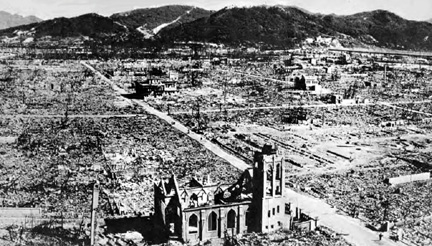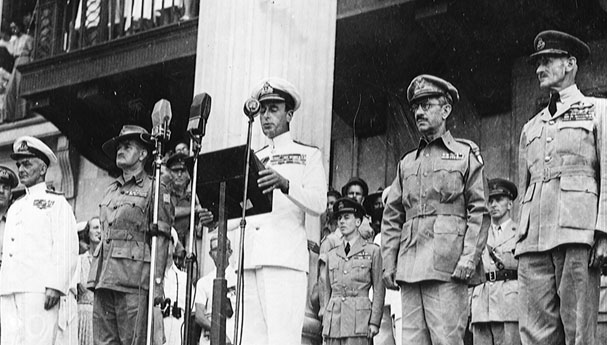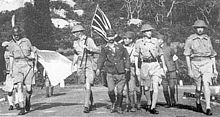
The Riots in the Early 1950s an Expression of Anti-British feelings?
Social and economic problems that people faced was still continued in the 1950s. The problems caused many people to be discontented with the British rule. 1950, ended up with a major riot.
One riot that I will use to examine , Maria Hertogh riots. The riot broke out over the custody battle of a 13-years old girl named, Maria Hertogh. Maria Hertogh was born in Java in 1937 to Dutch Catholic parents. During the Japanese Occupation, her parents was imprisoned, Maria then came under the care of a Malay woman, Che Aminah and her husband. They brought Maria up as a Muslim and named her Nadra.
In the year of 1949, Maria's mother, Adeline Hertogh, came back to claim her daugther from Che Aminah. Maria's case was brought to the High Court in Singapore and she was placed under the care of the Social Welfare Department
In May 1950, the court ruled that Maria should be returned to her natural parents. Che Aminah opposed the decision and sent in an appeal. Two months later, Maria was returned to Che Aminah.
Under Cheh Aminah care, Maria went through a marriage ceremony with a Malay teacher.
In November 1950, the battle of custody continued. The court ruled that Maria should be returned to her natural parents again. The judge announced that the Dutch law did not recognise Maria's marriage as she was under-aged and her natural father consent was not obtained. The Malays felt that the Muslim law was not respected.
When the court placed Maria in the care of a Catholic convent in Thomson Road. Widespread coverage of the custody battle in the English, Malay and Tamil newspapers began. Reporters and photographers entered the convent to take pictures of Maria.

On 11 December 1950, Che Aminah appealed again for the custody of Maria, the court sat to hear Maria's case. Large criwds was gathered outside the court at the Padang to know the verdict, the judge rejected the appeal. The Muslims felt betrayed by what they saw as the British was taking sides with the Dutch, supporters of minah at the Padang started to riot. Any Europeans or Eurasian was in sight was attacked, cars was overturned and burnt. Serious rioting erupted in the vicinity of Sultan Mosque, North Brige and Jalan Besar roads. It was a terrible and horrifying scenario, there were bloodshed , it was a storm of fire nobody expected, it all happened in a sudden.
The riot continued to go on for three days and a curfew was imposed for two weeks. Troops were called to maintain law and order, by the third day, everything was under control but 18people were killed and 173 people was injured during the riot.
~ ♥ ~
Every mistaken made, there's always a chance given to you, to turn over a new leaf. Everyone make mistakes, you just have to learn from your mistake and think about how to make better improvement on it instead of, sitting and having negative thoughts in your mind, nothing is impossible as long as your willing to do your best !
Adapted from : Ministry of Education, Singapore . [ Tuesday 12 February ]
Image taken from : http://www.mha.gov.sg/isd/images/ct-maria.gif ,
http://upload.wikimedia.org/wikipedia/en/9/95/SGstory_Maria2.jpg , https://blogger.googleusercontent.com/img/b/R29vZ2xl/AVvXsEhOG_PErAbP-xx41INhzpnZ9thwmyBPm4FrcrL2OitI4ZO-Gjp3FtNTFZMlyEvkIBbzlG7AKkyoZUIPvdJOUc8tzhrWGbwt09MFzmGSLd2iLUs_iw24BVvx_Uye3MWXRe23U4Fk0irv1f0/s1600/nadrah-riot.jpg ,
http://kentridgecommon.com/wp-content/themes/themasterplan_tma_v1.3.1%202%202/tma/
images/latest/riots1-530x330.jpg
[ Tuesday 12 February ]
|
Elections
In the year 1948, elections was introduced for the first time and the British allowed some locals to be elected into the Legislative Council. It was the first time, the people was given a choice in deciding who was going to be represent as their government. The conduct of election is an important feature of democracy.
During this event, there were only 13,800 people who turned up to vote in the election out of a total population of about 940,000. Because the British only allowed those who were born in Singapore to vote, some who was eligible to vote, did not took part in the voting as it was not compulsory.
~ ♥ ~
This was the first step towards democracy in singapore, and also a big step singapore took, having someone to represent our country and slowly it will continue to grow, as it grow , many more achievements are made hence we should be proud of our country ! because of the past we have the best future. The past affects the future and because there were leadership, Singapore turns out to be a good country with inspiring motto's therefore we should be thankful to the life we have today.
Adapted from : Ministry of Education, Singapore [ 11 February 2013 ]
Photos Taken from :
http://www.nestle.com.sg/Growing_Up_With_SG/Images/timeline/zoom/zoom_1959.jpg
[ 11 February 2013 ]
|
How did the Locals "Respond" to the return of the British?
The return of the British to Singapore on 5 September 1945, did not meant that the civilians return to their old good lifes, people were still not free from hardship. Thousands were jobless and are living in poverty. There was severe shortage of food, water, electricity and housing. People lived in slum ( Meaning: denoting one or more people or things already mentioned or assumed to be common knowledge) conditions. Due to overcrowded living conditions, diseases were common, poor sanitation and lack of health services. The attempted to solve the problems and putting Singapore back to its feet, these efforts were inadequate ( Means: Lacking the quality ).
How did Post-War Conditions affect the Response of the Local People to the British Rule?
There were many waves of strikes. Strikes took place very often in 1947, and was remember by people as " The Year of Strikes". There was more than 300 strikes by almost 70,000 workers. These strikes became worse with the involvement of the Malayan Communist Party (MCP), the Communists stirred up people's feeling against the British through the trade unions and blame the British for all the post-war problems. They encouraged the workers to join Communist-controlled trade unions to fight for better working conditions and higher pays.
While many locals were worrying about their livelihood, there were people who thought about the future of Singapore, their mindset towards the British ruling Singapore for over a hundred of years and had failed to protect it many times, they should therefore leave Singapore alone.
~ ♥ ~
Strike, refuse to continue working usually because they are demanding more pay or better working condition from their employers.
A trade union is an organised association of workers, the union aims is to improve the pay and working condition of its members.
~ ♥ ~
Having to take care a family, while living in poverty, it normal to be greed and wanting to get a better pay and give your child a better life, every parents do care a lot for their child in their hearts this is what I feel...
Adapted from : Ministry of Education , Singapore [ 11 February 2013 ]
|
What were the effects of World War II on Civilian Population,
Nation sufferes, at the same time it demonstrated the strenght of the human spirit as many sustained the zeal ( Meaning: great energy or enthusiasm in pursuit of a cause or an objective ) for life in face in the face of great challenges and adversity.
The Blizt on London and numerous English cities like Liverpool, Coventry and Manchester by the German air force, the Luffwaffe, was a sustained and concentrated bombing on the United Kingdom by Germany during 1940-1941. It was intended to break civilian morale and forcing them to surrender. Even though Luftwaffe was not successful, it managed to inflict serious damages, almost half a million houses were destroyed, 43,000 civilians dead and over 139,000 civilians was injured.
The Allies carried out regular bombing raids on Japan with devasting results. March 1945, there was a bombing raid in Tokyo, 80,000 civilians was killed in the huge firestorm caused by the Americans bombers.
On 6 August 1945, Hiroshima in southern Japan became the first city in the world to suffer an attack of an atomic bomb.
The dropping of "Little Boy" by Enola Gay, a B-29 Superfortress, resulted in a death of 80,000 civilians dying instantly.
It was three days later, On 9 August 45,000 civilians another atomic bomb, "Fat Man", was dropped on Nagasaki.
For the next few months, there were radiation poisoning, causing 50,000 civilians to die.
A video you can refer to for references of atomic bombs , " Little Boy " and " Fat Man " :
Adapted from : Ministry of Education, Singapore , History textbook [ 11 February 2013 ]
Photos take from : http://www.google.com.sg/ [ 11 February 2013 ]
Video taken from : Youtube.com [ 11 February 2013 ]
|
Bose arrived in July 1943,
Bose arrived in Singapore to Army ( INA ). The INA consisted of prisoners -of-wars (POWs) from the British Indian army and it was weak before Bose's arrival.
Bose was given an very warming welcome by the Indian community, he was a born leader with a dynamic personality, possessing a moving power of oratory. During his first public speech, Bose announced his plans to organise a Free Indian Provisional Government (FIPG).
In October 1943,
During a mammoth gathering outside the Cathay Building, the FIPG came as well. The event was witnessed by the Indians from all over Southeast Asia, in order to strengthen the INA, Bose toured the neighbouring Japanese-occupied territories including Bangkok, Rangoon, Saigon and parts of cause by joining the INA and contributed large amounts of money and jewellery.

INA became a major movement attracting two million Indian civillians and 55,000 Indian soldiers in Southeast Asia. Woman joined the INA and formed the famous " Rani of Jhansi". Even though the INA are under the control of Bose, the refused to be part of the Japanese army, instead they chose to be an independent army, fighting for the freedom of their motherland.
On 8 July 1945,
Bose laid the foundation stone at the INA War Memorial at the esplanade, Singapore, it is to commemorate the " Unknown Warrior" of the INA. The words inscribed upon the War Memorial were the motto of the INA: Unity ( Ittefaq), Faith (Etmad) and Sacrifice (Kurbani).
On 15 August 1947,
The INA did not succeed in their armed struggle, but their fervour and patriotism contributed to the eventual achievement of India's independence. At the famous Red Fort trials, attempts by the British to charge the INA with treason sparked off anti-British demonstrations. Not long after , India became independent.

Adapted from : Ministry of Education, Singapore , History Textbook [ 11 February 2013 ]
Photo URL : http://www.google.com.sg/
|
The Return & Surrender on 6 and 9 August 1945,
Atomic bombs were dropped on Hiroshima and Nagasaki. After their country was bombed, the Japanese surrendered.
On 5 September 1945,
The British troops returned to Singapore.
On 12 September 1945,
Huge crowds was gathered at the Padang and cheered for the returned of the British. In the Municipal Building ( Now known as City Hall ), Japanese military leaders signed the surrender document which was accepted by the Supreme Allied Commander for Southeast Asia Lord Louis Mountbatten.
( Lord Louis Mountbatten reading the Order of the Day about the Japanese surrender from the steps of the Municipal Building. )
Adapted from : Ministry of Education , Singapore , History Textbook [ 11 February 2013 ]
Photo URL : http://www.google.com.sg/ [ 11 February 2013 ]
|
On 15 February 1942, The surrendering to the Japanese
Is the year of Chinese New year, the British had a final conference at the Fort Canning bunker. Lieutenant-General Percival wanted to discuss ways to counter attack the Japanese but his commanders was against the idea. They felt that there were too many problems and during that time their soliders was already exhausted. More lifes of men would be sacrificed if they were to engage the Japanese in street fighting. Furthermore, the British are running out of supplies of food and water. To prevent anymore bloodshed, they opted to surrender themselves to the Japanese.
On 15 Februaty 1942, Japanese Lietenant-Colonel Sugita leded Lietenant-General Percival and his delegation to the Ford Motor Factory to negotiate the surrender terms. 
Adapted from : Ministry of Education, Singapore , History Textbook [ 11 February 2013 ]
Photo URL : http://www.google.com.sg/ [ 11 February 2013 ]
|
|






 Tuesday 12 February 2013
Tuesday 12 February 2013 








